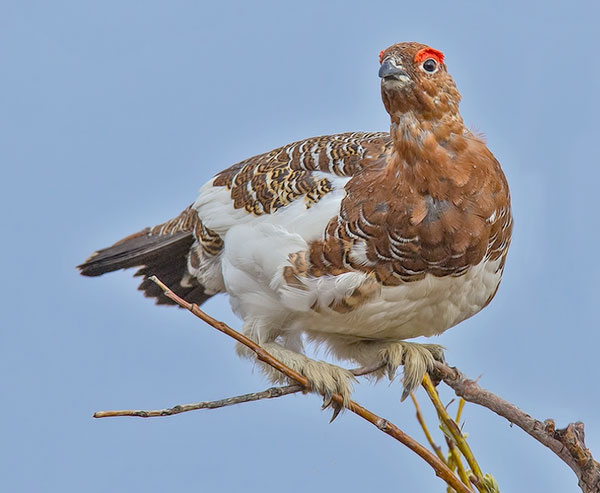
The Alaska state bird is the Willow Ptarmigan – it’s only found in one state in the U.S. Outside of Alaska, the Willow Ptarmigan can be found in Canada, northern Europe, Siberia, and the tundra of Scandinavia.
Alaska is an extreme Northwest U.S. state whose terrain consists of vast glaciers, rugged mountains, long coastlines, tundra, and boreal forests. The capital of the state is Juneau. It’s an enormous state with a population of 732,673 and a 665,400 sq mile size.
Your best chance of finding Willow Ptarmigans is in the spring. The birds, males especially, perch on fence posts or in bushes and walk defiantly along roads. They even tolerate a close approach. These birds are harder to find in the summer months because they camouflage well against the tundra.
Overall, Willow Ptarmigans are fairly common, so carefully scanning their habitats should allow you to see a few. In the winter, look for flocks of these birds where patches of willow protrude above the snow. However, it’s important to note that they also hide in burrows.
On this page
History of Alaska State Bird
The Willow Ptarmigan (Scientific name: Lagopus lagopus) was picked as the state bird of Alaska in 1955. However, at this time, Alaska was not yet a state.
That same year, the Territory of Alaska leaders were creating a constitution to prepare for statehood.
Schoolchildren in Alaska chose this bird as a symbol of the Great Land, and it became the official state bird of Alaska when it became the 49th state in 1960.
It was chosen due to its ability to camouflage from predators and its resourcefulness in being able to change its plumage from summer’s light brown to snowy white during winter.
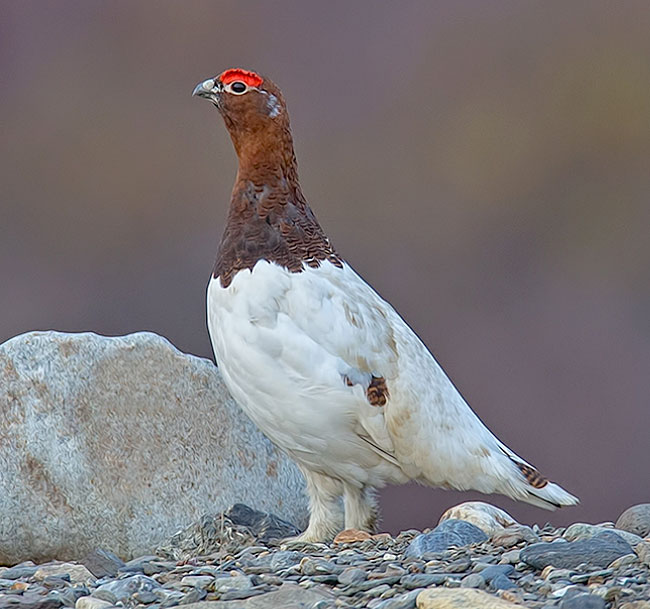
Facts about The Willow Ptarmigan
- In the winter months, these birds form flocks where food is abundant. Flocks can be as big as 2,200 birds! In eastern Canada, migratory flocks of Willow Ptarmigans have even been seen offshore, landing on ships well out to sea or oil-drilling platforms.
- Willow Ptarmigans defend their babies from predators by luring attackers away by pretending to have a broken wing or dive-bombing intruders.
- Willow Ptarmigans tend to play with each other when in groups. For example, one bird will initiate play by extending and bobbing their head, then jumping around, and flapping their wings alternately. Other birds will join in by doing similar moves. It’s believed that this increases cohesion of the social group and sharpens motor skills.
- These birds have thick feathers that conceal their nostrils. This prevents snow from getting in.
- The Willow Ptarmigan is the only grouse on the planet where the male ptarmigan frequently helps raise the young. Pairs of these birds will remain together from the start of the breeding season until the chicks are independent. This is a period of around 7 months.
- These arctic grouse breed in tundra and . They are resident in northern parts of the U.S. and Canada, northern parts of Europe (Scandinavia and the Baltic countries, even Scotland and Ireland) and Russia.
Identification of Alaska State Bird
Willow Ptarmigans are chunky, white birds with large, feathered feet, short necks, small heads, and small bills. They’re larger than a quail and smaller than a teal.
These birds are nearly completely white, have dark eyes, bills, and tail feathers during the non-breeding season. During the breeding season, males are reddish-brown overall, dark tail feathers, and have dark barring. Their bellies, legs, and wings remain white.
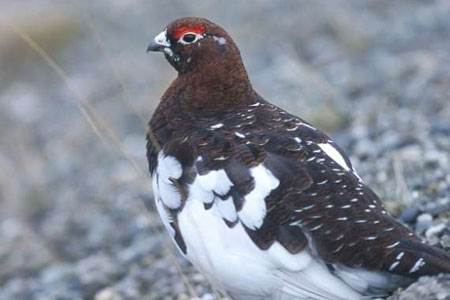
Willow Ptarmigan
Willow Ptarmigans are 13.8 to 17.1 inches (35 to 43.5 centimeters) long, weigh 19.0 to 23.6 ounces (538.1 to 668.6 grams), and have a wingspan of 23.6 to 24.4 inches (60 to 62 centimeters).
Female Willow Ptarmigans look similar to breeding males. They have intricate dark and pale brown splotches, are the same size and length, and have the same wingspan as males.
Regional Differences
There are 19 named subspecies in the world. 6 of those 19 are in North America, but more studies need to be done to determine whether differences between Willow Ptarmigan populations support these differences.
Call
Male Willow Ptarmigans are extremely vocal during territorial and courtship defense. In these displays, they often produce what some call a “flight song.” This song involves a series of clucks and rollicking.
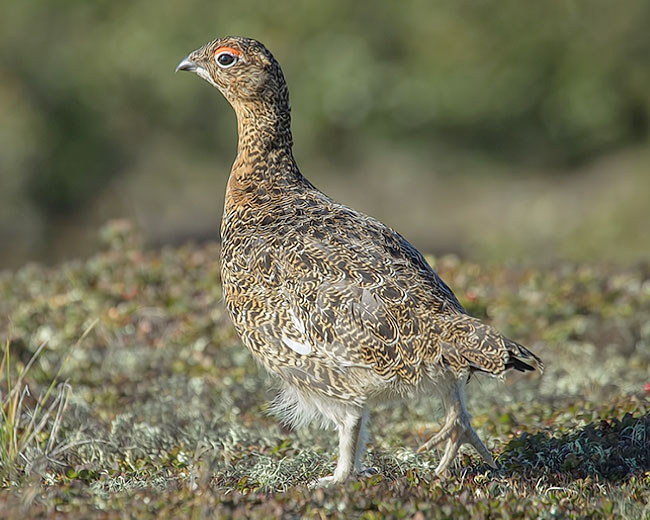
Additionally, these birds are vocal doing the nesting season. They truly have a remarkable repertoire of calls. Many of them can sound comical and even humanlike! Both females and males produce a sequence of growls and nasal clucks for a variety of reasons; it can be for conflict with rivals, contact with mates, or even notifying others of the presence of predators.
Males that are displaying will snap their tail feathers into a fan, which makes an audible noise, and drag their wingtips loudly across the ground.
What do they eat?
Willow Ptarmigan’s diet mainly consists of plant matter, seeds, and berries. During warmer months, they also feed on insects.
They like leaves, flower buds, twigs, and plant matter such as birch, blueberry, willow, arrowwood, and barberry.
Behavior
Willow Ptarmigans are very territorial birds in the spring. Males aggressively defend their territories from other males. Once they’re mated, hens will defend the territory as well from other females.
These birds can have territories anywhere from 3 to 20 acres. Female birds will arrive at the breeding grounds around 2 weeks after the males and observe either in small groups or singly as males put on their display.
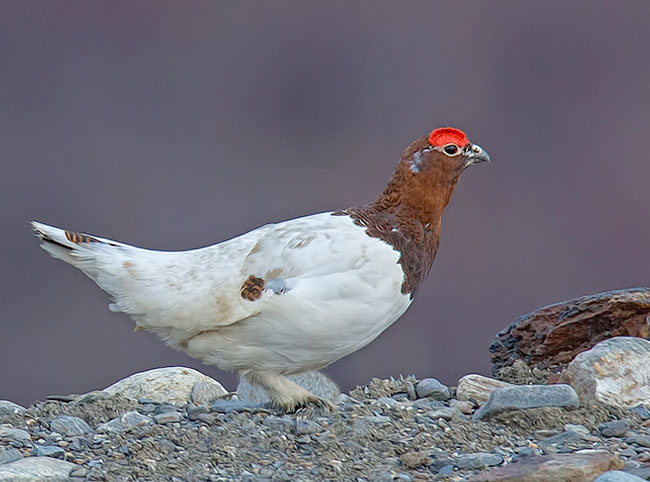
Willow Ptarmigan in winter
To attract females, male birds perform complicated courtship displays that involve flicking and fanning the tail, spreading its wings, parading, bowing, and drumming with their feet. Males also erect their red eye-combs. Through studies, it has been found that females tend to choose males that have more energetic displays and larger combs.
When rival males intrude into an existing male’s territory and cause conflict, either a chase ensues or a series of threat displays is performed with a lot of vocals. Willow Ptarmigan pairs will stay with each other during courtship, and males will guard females through the incubation process.
Only female birds incubate the eggs. This is actually uncommon for a lot of bird species. Some male Willow Ptarmigans are polygynous, meaning they have several female partners. In cases like this, the second female will defend a smaller territory that’s inside the male partners’ territory.
The Willow Ptarmigan is the only grouse species in the world where males stay with the female and brood to defend them. The pair can be together for up to 7 months. After the young Willow Ptarmigans fledge, adults will move upslope to molt into their winter plumage.
In some instances, they’ll return to their breeding territories to feed until harsh winter weather compels them to move downslope.
People Also Ask
What is the state bird of Alaska?
The state bird of Alaska is the Willow Ptarmigan.
Why is the Willow Ptarmigan the state bird of Alaska?
The Willow Ptarmigan was chosen as the state bird of Alaska because it is a well-known and iconic bird in the region. Its ability to change its plumage color from brown in summer to white in winter enables it to blend with the surroundings, making it well-adapted to the arctic and subarctic environments of Alaska. The Willow Ptarmigan symbolizes the resilience and adaptability of Alaska’s wildlife.
When did Alaska choose its state bird?
Alaska designated the Willow Ptarmigan as its state bird in 1955.
What other states have the Willow Ptarmigan as their state bird?
The Willow Ptarmigan is exclusively recognized as the state bird of Alaska and does not hold the same designation in any other states.
More in Alaska: Most common birds | Ducks

